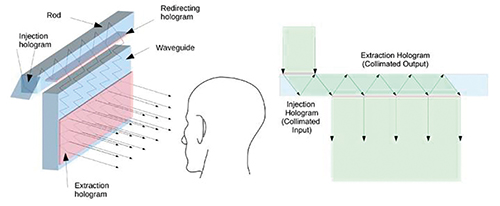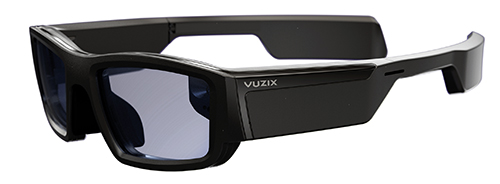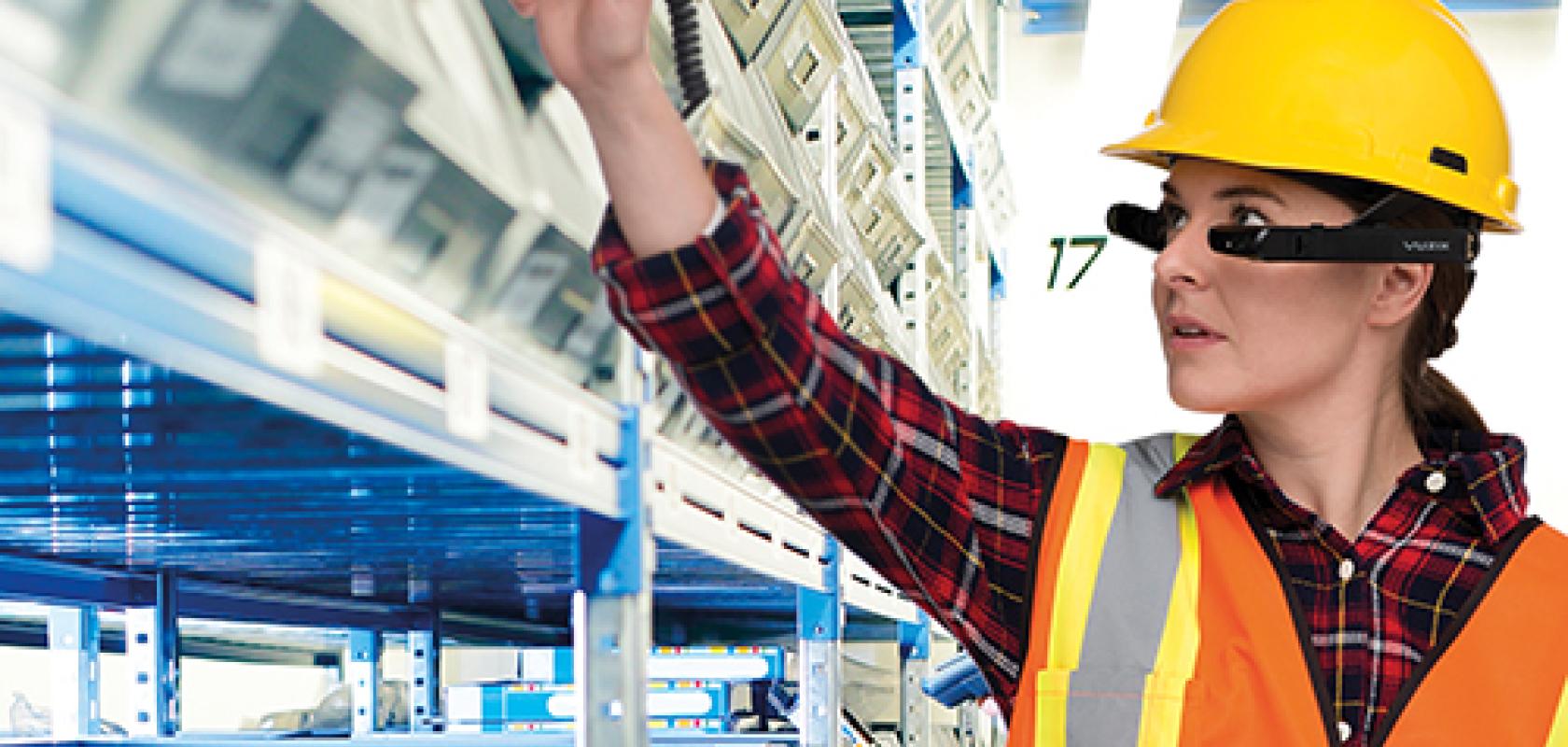Although it’s not yet commonplace to see the public wearing AR glasses, they are being used to improve safety and efficiency in certain workplaces. For example, helping warehouse pickers find goods more quickly and accurately, or to help engineers repair wind turbines.
Industry has been AR’s entry market because it will accept conspicuous-looking designs, if they perform well and provide valuable functionality, according to Phil Greenhalgh, chief technology officer of UK-based WaveOptics. ‘Consumers simply want a pair of glasses like yours or mine,’ he said. AR companies are therefore seeking smaller waveguides, perhaps in the hope of displacing smartphones as our conduit to digital information.
WaveOptics helps companies produce such headsets by designing and making waveguides, which become see-through near-eye AR displays. This involves directing images from light engines in the arms or at the top of the headset into users’ eyes.
Today, AR headset vendors often discuss holography as the technology that gets images into people’s eyes. For example, Microsoft unveiled its HoloLens 2 ‘smartglasses’ at the Mobile World Congress in Barcelona, Spain, in February 2019. That terminology is both misleading and confusing, according to Greenhalgh. HoloLens 2 is ‘just not a hologram,’ he stressed. ‘It’s probably more correct to talk about diffractive optical elements, which is what we use.’
Yet companies and researchers are exploring how holographic processes can help create appealing AR images in people’s eyes. Among them is Pierre-Alexandre Blanche, from the University of Arizona, US. Blanche explained that the name hologram is a second cause for confusion. The name is used to refer both to an optical component and the image it creates. ‘A holographic optical element can be a diffractive element that reproduces either an image, which could be 2D or 3D, or an optical function, which could be a mirror or a lens,’ Blanche said. ‘If you take two slits that have a diffraction pattern, it’s not a hologram. If you take a million slits that have been very precisely calculated to produce something useful, that becomes a hologram.’

Pierre-Alexander Blanche has developed a heads-up display that uses holographic optical elements to inject an image into the glass, or waveguide (left). The light enters the glass and bounces back and forth between its front and back edges until it reaches another holographic optical element that extracts a small portion of light that leaves the glass with each bounce (right). The extraction holographic creates a viewable image, with each bounce proportionally increasing the eye box size for the image
Existing AR systems often exploit holograms or diffractive gratings to inject light into waveguides and extract it again. ‘You can do that with small mirrors, for example, and embed it inside the waveguide,’ Blanche said. ‘You can do it with a prism. There are advantages to use holograms instead of those elements. If you put a small prism inside it, it’s difficult to see through it.’
Looking at infinity
‘The whole problem with AR is how do you look at something that is totally clear, and see at infinity the desired image,’ said Mike Medora, chief technology officer of London-based TruLife Optics. ‘The thing is only 20mm from your eyes. How can you look at something that close? You want an optic that allows you to see through with this moving image, and is comfortable. Holograms are a very elegant way to do it.’
TruLife Optics makes holographic optical elements, including wave couplers. Its input coupler takes an image projected by a light engine, which is typically collimated by a lens. When brought directly to your eye ‘you would see the image at a nice comfortable distance’, Medora explained. The coupler can be a reflective hologram that turns incoming light 45˚ as it enters a waveguide. ‘The light travels along the glass and it’s confined in the glass by total internal reflection,’ Medora said. ‘Then it bounces out in the correct way from the output coupler, which is transparent. The coupler is either a thin piece of holographic film, or a thin piece of glass, and then that goes on the glasses.’
For mass production, such holograms can be made from photosensitive polymers. But the early stages of recording holograms are critical, and so TruLife Optics has developed its own silver halide photosensitive emulsion to ensure optimal outcomes. ‘Holograms still are generally created by lasers, and interference from the wavefronts,’ Medora said. ‘The normal definition of holograms is a pattern of light that can be recreated to give the content, which was created using two wavefronts. When one is played, the other is played back.’ Two waves with exactly the same frequency interact to produce the hologram, requiring highly coherent lasers whose wavelength doesn’t change during exposure. ‘Also, you can’t have any vibration,’ Medora added. ‘You have to have special isolation tables to make those exposures.’

An HUD using a TruLife Optics waveguide over the London Skyline
Blanche explained that waveguides can give a very large eye box – the volume where users’ pupils need to be to experience the AR visuals wholly. Looking at a waveguide, users prefer a wide ‘field of view’ angle, so that the image they see appears larger. ‘Inside the waveguide you need to have all the beams collimated, and it’s only when you extract it that you can increase that angle,’ Blanche said. ‘Holographic optical elements can do that.’
The large eye box is usually produced in a process known as pupil replication. Greenhalgh explained that AR systems’ light engines produce tiny ‘pupil replicas’ of a projected image. With just one such image, it would need to be very precisely aligned. Therefore pupil replication places many copies across the waveguide. ‘Your pupil intercepts separate parts of different replicas and integrates them all together,’ Greenhalgh said. ‘The closer you can get the pupils together the smoother the image.’ Usually, companies produce a two dimensional matrix with two diffractive gratings, one creating replicas on the horizontal axis, the other spreading them out vertically. However WaveOptics can do this with just one non-hologram diffractive grating.
Great things from gratings
AR waveguides today are almost exclusively diffractive. Input coupling into diffractive waveguides most commonly exploits components called surface relief gratings. WaveOptics produces designs for two gratings, one for red and some green colours, and the other for blue and the remaining green colours. ‘We create a replica of that digital description in silicon,’ Greenhalgh underlined. ‘It is brought into contact with a glass wafer with resin on it. The silicon wafer is lifted off and then it’s bombarded with ultraviolet light that cures it into a hard layer. Then we cut them out and stack them together.’
AR headset maker Vuzix is convinced that surface relief gratings are best suited to its products, explained Paul Travers, its chief executive officer. ‘Vuzix utilises thin planar substrates with surface relief gratings that operate as a waveguide and that are packaged into our glasses without sacrificing performance across the parameters we design to,’ Travers told Electro Optics. He’s careful to differentiate them from holographic components.
Based in Rochester, US, Vuzix built its first diffractive waveguide systems for the US Defence Advanced Research Projects Agency in 2009, Travers recalled. ‘Since then we have pushed the boundaries for form factor, power consumption, size and flexibility of design,’ he said. ‘The firm combines the waveguides with its custom display solutions and folds the entire system into a package that is small, light and high performing.
In January, Vuzix launched its Blade AR smart glasses, which have been integrated with facial recognition, a drone control app and real-time translation. The Blade glasses include a stack of two waveguides. ‘Each waveguide relays a portion of the visible spectrum and then recombines that light into one image,’ Travers said. ‘The parallelism requirements for each plate to maintain pixel accuracy – to put that image back together correctly – is ridiculously tight and just how we maintain that is part of the magic.’
Another challenge comes because light enters every Blade waveguide through an input grating. ‘Any light that does not get into that aperture is wasted and shows up as stray light, heat or both,’ Travers said. ‘From the perspective of the display, optical efficiency and addressable pixels, a tailored output in angle and wavelength are key.’

Vuzix Blade smartglasses combine two waveguides with light input and extracted via surface relief gratings
Beam splitters and conventional optics can also achieve see-through experiences, but tend to be bulky, he noted. Waveguide solutions that use reflective and refractive elements can be hard and expensive to make, and put limitations on form and function, he added. ‘Diffractive waveguides offer a compact, flexible solution that, frankly, can outperform other technologies across the board if done properly.’
WaveOptics’ Greenhalgh outlined a number of fundamental problems facing holographic components in AR. The sensitivity to vibration during initial production of the hologram is one. Another is that to function as intended, the hologram has to be illuminated with a very similar wavelength of light to which it was made with. ‘That can be a bit of a challenge in practical devices,’ he said. ‘Also the structure is just a series of planes of refractive index changes. If the image has some form of distortion it’s very difficult to work out why. Surface gratings are things that you can physically put on an electron microscope and examine and can be modelled a lot more easily.’
A window for holograms?
However, Greenhalgh conceded that surface relief gratings do have shortcomings. For example, chromatic aberration causes fringes of colours after diffraction, known as the ‘rainbow effect’. This doesn’t happen with holographic input couplers. However, for diffractive waveguides ‘there’s no question that the surface relief gratings are a lot more successful,’ he concluded. Yet holograms can ‘work quite well’ for coupling light into waveguides, he said.
Public acceptance of existing AR systems is limited, University of Arizona’s Blanche noted, which creates an opportunity for holographic components. ‘[AR Systems] are still bulky and heavy, with a small image size,’ he said. His work therefore focuses on improving systems and changing their configurations using holograms and other techniques. ‘One specific aspect is free-form optics, a waveguide not necessarily flat but curved,’ he said.
Blanche has worked on producing an AR heads-up display integrated into a car windshield. ‘The advantage of using a hologram is that they’re really thin, they’re flexible, and there’s a lot of optical functionality that we can integrate into a hologram,’ he said. ‘That is difficult to reproduce with just a piece of glass or a mirror, so it’s very well suited for that application, because of the compactness and the robustness and how large they could be.’
For TruLife’s Medora, it’s important that holograms empower designers to look at moving beyond waveguides, to ‘free space holograms’. For such purposes, TruLife Optics makes simple mirrors and more complex off-axis concave mirrors. These can be used on the front panels of glasses and headsets. They reflect images projected from a light engine in the glasses’ arms, back into wearers’ eyes. ‘It’s a full colour holographic optical element that doesn’t exist as a linear diffractive element,’ Medora said.
He added that TruLife Optics exploits Bragg planes in thick holograms, places of maximum and minimum interference, ‘which gives immense flexibility of design with red/green/blue included in a single layer’. Although Medora can’t name TruLife Optics’ clients, it is common knowledge that a reflector approach is used by Canadian firm North in its lightweight Focals AR glasses.
Medora added that the idea can also be used for AR heads-up displays in vehicles. ‘Holography’s got a lot going for it, because it can be quite cheap. It can replace a huge amount of optics in just one thin layer of hologram. It can be totally clear, and it can work at high efficiency,’ he emphasised. That improved efficiency can help AR glasses’ battery lifetime and keep electronic chips involved cooler.
Whichever optical technology powers it, AR is set to be transformative. ‘Allowing the digital world to connect to the real world is going to change many aspects of our everyday lives,’ said Vuzix’s Travers. ‘From enterprise to entertainment, this technology is going to be everywhere. The ability to connect digital assets and the Internet of Things to the real world can be done with smart glasses better than any other way. As the form factors get slimmer, this technology will be on a path to replace the smartphone.’


